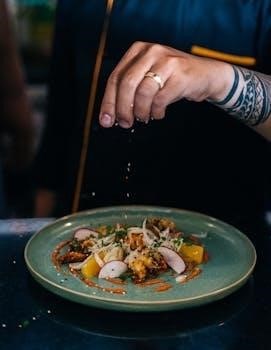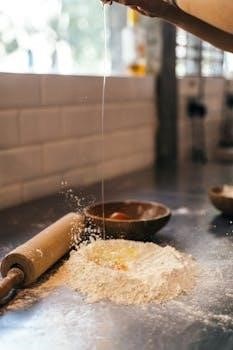This section introduces sous vide cooking, a method using precise temperature control. A key element is the easily readable cooking chart, providing information on cooking levels, core temperatures, water bath temperatures, and approximate cooking times. It is important to follow safety guidelines.
Overview of Sous Vide Cooking
Sous vide cooking, also known as low-temperature cooking, involves sealing food in airtight bags and immersing them in a precisely heated water bath. This method ensures even cooking, eliminating the risk of overcooking. The consistent temperatures allow for predictable results, which is especially useful for achieving specific levels of doneness. It’s suitable for various foods such as meats, poultry, fish, seafood, fruits, and vegetables, each requiring different temperatures for optimal cooking. Sous vide also excels at recipes that demand exactness, like custards and soft-boiled eggs. Because different foods cook at different temperatures, it’s often best to cook them separately. This technique often involves individually portioned foods to shorten cooking times. After sous vide, foods are frequently seared briefly, before or after, to enhance their texture and flavor. Using a sous vide circulator, a device that heats and circulates water, is essential for maintaining the required temperatures.

Understanding Temperature in Sous Vide
Temperature is crucial in sous vide, with different foods requiring specific ranges. Core temperature is key to ensuring the food is cooked through. Understanding these temperatures helps achieve desired results.
Core Temperature Importance
Achieving the correct core temperature is paramount in sous vide cooking, as it directly impacts both the safety and the final texture of the food. Unlike traditional cooking methods, where heat is applied from the outside and can lead to uneven cooking, sous vide ensures that the entire piece of food reaches the same precise temperature throughout. This is crucial for eliminating harmful bacteria and ensuring food safety, especially with meats and poultry. The core temperature determines the level of doneness, whether it’s a rare steak or a perfectly cooked piece of fish. Monitoring this temperature with a thermometer, particularly a probe designed for sous vide, is essential for consistent and predictable results. The core temperature is the point at which the proteins in the food coagulate, affecting its final texture and tenderness. This control over the core temperature is what makes sous vide such a reliable method of cooking.
Temperature Ranges for Different Foods
Sous vide cooking requires specific temperature ranges for different types of foods to achieve optimal results and ensure safety. For instance, fish often cooks within a range of 41°C to 65°C, while beef, pork, poultry, and game typically require temperatures between 50°C and 85°C. Vegetables and fruits are often prepared at different temperatures, as they do not cook at the same rate as meats. It’s crucial to cook fruits and vegetables separately from meats to accommodate these temperature differences. The precise temperature for each food depends on the desired level of doneness. For example, a rare steak needs a lower temperature than a well-done one. Using a detailed sous vide temperature chart is helpful to ensure that the correct temperatures are chosen. Maintaining these temperature ranges is essential for achieving the desired textures and flavor profiles in sous vide cooking.

Time Considerations in Sous Vide
Sous vide cooking involves various time considerations, including the time it takes for the core of the food to reach the desired temperature and the total cooking time, factoring in food size.
Cooking Time at Core Temperature
The cooking time at core temperature is a crucial element in sous vide technique, defined as the duration required for the food’s center to reach the target temperature. This is not just about heating through; it’s about achieving a specific level of doneness. For instance, a beef fillet, lamb rack, or fish will all require different durations to reach their respective ideal core temperatures. The times vary based on food type and size. Using a precise sous vide chart will help guide you for each item, ensuring it’s cooked perfectly. It’s also critical to understand that once the core temperature has been achieved, the food is cooked to the set level, ready to be served. Therefore, a thermometer, preferably a sous vide probe, is essential to accurately monitor this process; Remember that time will be also influenced by the starting temperature of the food.
Total Cooking Time Factors
Several factors affect the total cooking time in sous vide beyond just the time to reach core temperature. The initial temperature of the food plays a significant role; frozen items, for example, will require extended cooking times compared to thawed ones. The thickness of the food is another key factor; thicker cuts will need longer to reach the desired core temperature. Furthermore, the desired level of doneness influences the total time, with each level having a unique temperature and time profile. The size and shape of the food also matter, as these impact heat transfer rates. The material of the bag being used can also have an impact. Lastly, some recipes may require searing before or after sous vide, adding to the total time. Understanding these factors will allow you to adapt your cooking plan and achieve the best results.

Practical Application of Sous Vide Charts
This section explores how to use sous vide charts effectively, focusing on adapting cooking times based on food size. It also examines the practical application of the charts for daily cooking needs.
Using a Sous Vide Temperature Chart
A sous vide temperature chart is an essential tool for achieving consistent and perfectly cooked meals. These charts typically provide information on recommended temperatures and times for various foods, including meats, poultry, fish, and vegetables. The core temperature of the food is the critical factor to monitor, ensuring that it reaches the desired level of doneness. When using a chart, it’s important to note that the given times are often starting points and may need adjustment based on the thickness and size of your food. For example, a thicker cut of meat will require more time to reach its core temperature than a thinner one. Also, different charts may have slight variations, so it is recommended to cross-reference multiple sources when possible. Furthermore, always consider the specific type of sous vide equipment you are using as this may affect cooking time and results.
Adapting Cooking Times Based on Food Size
Adapting cooking times based on food size is crucial for successful sous vide cooking. The provided charts are guidelines, and the thickness of your food directly impacts how long it needs to remain in the water bath. Thicker cuts of meat, for instance, require significantly more time to reach the desired core temperature compared to thinner pieces. Conversely, smaller portions might cook faster than specified on the chart. When adjusting cooking times, consider that the goal is to achieve even heating throughout the food. The time it takes for the center of the food to reach the target temperature is what dictates total cooking time. It’s helpful to use a reliable thermometer to check the internal temperature, especially for larger items. Remember that it’s better to err on the side of caution and extend cooking time slightly, particularly when cooking large portions.

Safety and Hygiene in Sous Vide
Food safety is paramount in sous vide. Using appropriate, food-grade materials is crucial. Always follow hygiene protocols. Maintaining proper temperature is critical to prevent bacterial growth and ensure safe consumption.
Importance of Food Safety
Maintaining impeccable food safety is absolutely critical when using sous vide techniques. Due to the low-temperature cooking environment, it is essential to understand the risks involved and implement strict practices. Proper handling of raw ingredients before and after the sous vide process is paramount. Bacteria can thrive in the temperature ranges often used in sous vide, so time and temperature control are vital to prevent foodborne illnesses. Using appropriate, food-grade vacuum bags and sealing them properly is a must. Always ensure that the food has reached the required core temperature to eliminate pathogens. Furthermore, pay attention to the total cooking time, particularly when working with potentially hazardous foods. Adhering to established guidelines and using a reliable sous vide immersion circulator will greatly contribute to safe and delicious results. Proper labeling and storage after cooking are also important to avoid cross-contamination and ensure the quality of the food.
Equipment and Material Considerations
Selecting the right equipment and materials is crucial for successful and safe sous vide cooking. A reliable immersion circulator or sous vide machine is essential for maintaining precise temperature control throughout the cooking process. The water bath container should be heat-resistant and of appropriate size to accommodate the food being cooked. The vacuum bags used must be food-grade and capable of withstanding the cooking temperatures without leaching harmful substances. For vacuum sealing, you’ll need a vacuum sealer, ensuring that the bags are properly sealed to prevent water ingress. When using a suction vacuum machine, it might be necessary to freeze the olive oil for about 12 hours beforehand. Consider using a fine probe thermometer to verify the core temperature of the food, using a special probe for sealed bags. These tools and materials are essential for safe and precise sous vide cooking.
